
Status report: Streamlining WDG interconnection
A brief history of the Clean Coalition’s work in this key area and a look at what lies ahead.
- Wholesale distributed generation (WDG)
- The WDG interconnection problem
- Streamlining WDG interconnection
- Progress on WDG interconnection
- WDG interconnection pilot
- Best practices report
- The work ahead
California aims to get to 50% renewables by 2030 and 100% carbon-free electricity by 2045. How will we get there?
To achieve our goals, we’ll need a mix of remote and local energy generation. With over 1 million solar roofs in the state and enough solar to power over 6 million homes – much of that coming from utility-scale installations – California is solidly placed as a national solar leader. But one solar market segment remains woefully underserved in the state.
The missing piece: Wholesale distributed generation (WDG)
That underserved market, wholesale distributed generation (WDG), is crucial to achieving our clean energy goals.
WDG = distributed energy generation, often commercial-scale solar, that interconnects to the distribution grid and serves local loads, avoiding use of the transmission grid.
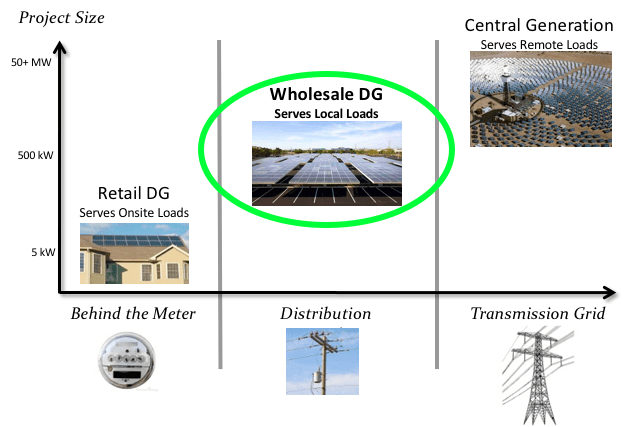
Rather than serving just one customer, WDG systems bring an entire community a host of important benefits – while avoiding the expensive, inefficient transmission lines required by remote power generation. The Clean Coalition has identified ample solar siting opportunity for WDG on rooftops, parking lots, and parking structures in urban areas.
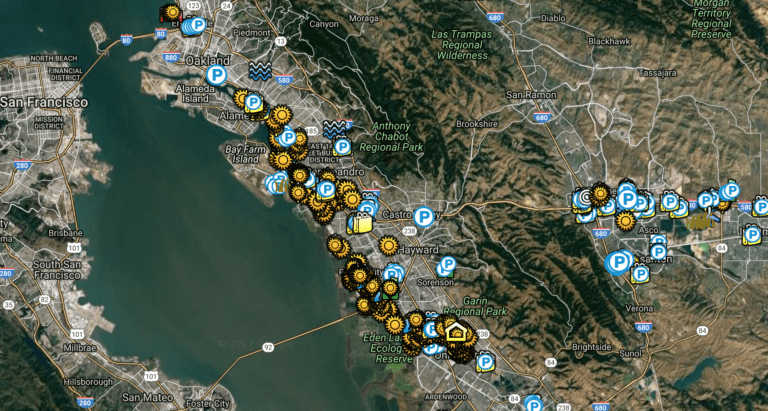
WDG is the market segment that catapulted Germany to become a global solar leader, despite having solar resource akin to that of Alaska. With 70% more sunshine than Germany, California has no excuse to lag behind.

The WDG interconnection problem
Why haven’t we deployed more WDG? While the reasons are numerous, a major one is challenges related to interconnection.
Interconnecting a WDG project to the grid in California can take years, and it can be arduous and expensive. Compared to the process for identically sized and similarly sited Net Energy Metered (NEM) projects in California, interconnecting WDG projects costs significantly more, takes longer, and is far less predictable.
Because of the uncertainty and extra costs, many WDG projects don’t get off the ground or are never even considered. Those that are attempted run into significant hurdles, a case in point being the recent delays getting a microgrid built in Long Beach, California.
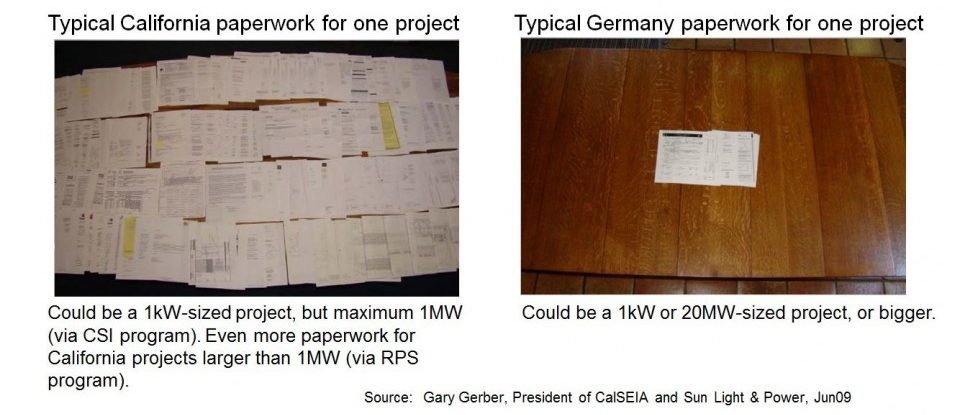
Just as it did in Germany, fixing WDG interconnection in California will result in much more clean local energy here. While we still have work to do, the good news is that significant progress has already been made to streamline WDG interconnection.
Streamlining WDG interconnection
Since 2011, the Clean Coalition has been engaged in successful efforts to streamline WDG interconnection:
- Researching best practices around the world.
- Gathering information from stakeholders to understand the issues that arise.
- Identifying solutions and improving transparency.
- Publishing the Model Interconnection Procedures.
- Intervening in California Public Utilities Commission (CPUC) proceedings on Electric Rule 21, a tariff in California that defines the interconnection, operating, and metering requirements for generation facilities to be connected to a utility’s distribution system.
- Proposing and supporting updates to Federal Energy Regulatory Commission (FERC) utility guidance.
- Conducting work on the Peninsula Advanced Energy Community (PAEC) Initiative funded by the California Energy Commission (CEC).
When we began this work, most of the interconnection process for WDG and NEM projects was still being done on paper. The databases being used were incompatible. And while the proliferation of NEM projects pushed the investor-owned utilities (IOUs) to handle much higher volumes of smaller, low-impact facilities, the IOUs did not apply this same streamlining to WDG projects.
In addition to benefiting from streamlined interconnection, most NEM projects are small enough that their impact on the distribution grid is negligible. NEM projects smaller than 1 MW are not responsible for paying for grid upgrades. WDG systems of any size, however, are subject to these costs.
Progress on WDG interconnection
To make the process more efficient and transparent, we’ve led these significant improvements to WDG interconnection:
Transparency:
- Distribution resources planning (DRP): DRP seeks to optimize utilization of existing electricity grid assets and new DER resources to modernize the grid while minimizing costs for ratepayers. The Clean Coalition’s work in DRP proceedings at the CPUC began in 2011, when we drafted DRP legislative language in California. Once this language was adopted in Assembly Bill 327 in 2013, the Clean Coalition guided the CPUC implementation of DRP, and we remain active in DRP proceedings.
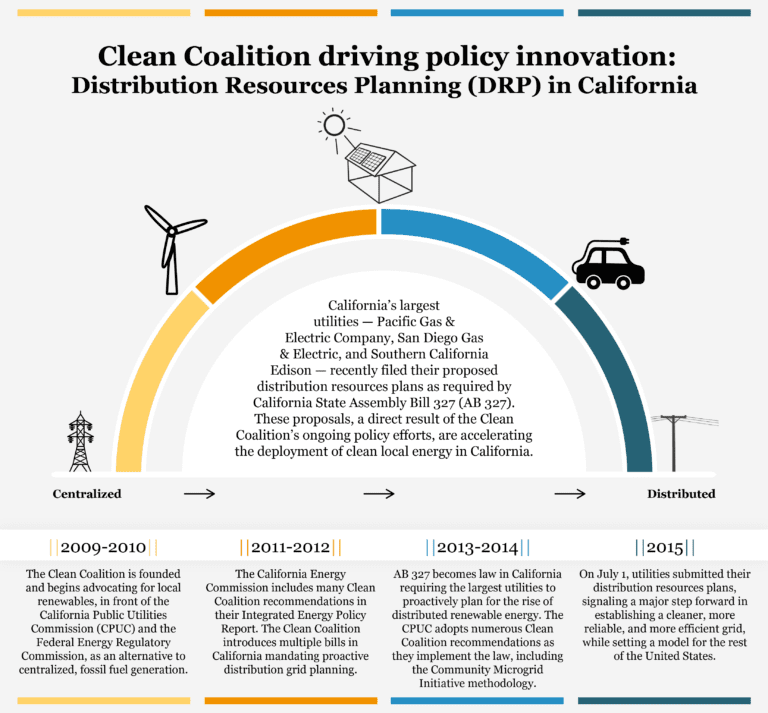
- ICA maps and Grid Needs Assessments: Our work in DRP proceedings has resulted in requiring California’s IOUs to produce and update Integration Capacity Analysis (ICA) maps, online grid maps that greatly increase transparency by providing a high level of detail on available interconnection capacity. The IOUs are also required to produce an annual Grid Needs Assessment report, which shows where there is both greater demand for and greater value in interconnection – allowing investment to be directed to those areas.
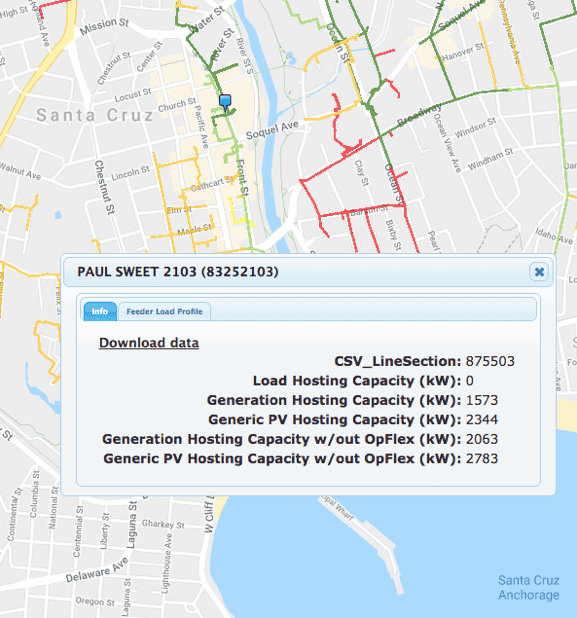
- Pre-application reports: These reports provide detailed information about grid capacity, known issues, transformer status, what projects are ahead of the applicant in the queue, and more. The information provided allows applicants to better evaluate the suitability of a site, identify known interconnection issues, and optimize their facility size to minimize grid upgrade costs. By increasing transparency for developers, the reports have made the interconnection process much more predictable.
Efficiency:
- Automation: Substantial improvements have been made in automating the interconnection review process, and we continue to push for further improvements. The Clean Coalition has developed and supported over 20 currently pending automation improvement proposals and pressed for a roadmap to guide implementation.
- The interconnection application process is now almost all electronic, eliminating paper application, ink signatures, and paper checks. Standard diagrams, checkboxes that allow the system to process the application through screening steps, and data entry error flags have greatly improved application acceptance rates and initial review times.
- Residential projects are typically approved within three days, with just the application submission and acceptance process automated thus far. Automating every step of the application in one online session would make the process instantaneous.
- Further automating interconnection for larger projects requires further improvements to the ICA maps, which will result in a more complete grid model. That will allow grid impacts of a proposed facility to be seen on the model in real time, mitigations to be tested, and a final agreement to be completed on the spot. It will be some years before each utility has aligned its processes to take advantage of this potential.
- Standardization: While a good deal of work remains to be done, much of the interconnection process, such as interconnection agreements, can be standardized. Standard electronic templates for designs mean that developers don’t have to submit individual drawings for each project.
- Fast Track Process: Screening questions have been added to avoid the need for an engineer to model and calculate grid impacts. A supplemental review gives a quick look at projects that fail one of the initial screens, usually leading to quick resolution of issues and allowing these projects to remain in the Fast Track Process. The process has further room for improvement, so we continue to monitor it and suggest enhancements.
Cost certainty:
- Per Unit Cost Guides: Each IOU now publishes a guide listing the cost of items that might be needed for a grid upgrade, such as new poles. These guides include both component costs and examples of a variety of project sizes, energy sources, and locations deemed relevant to interconnection applicants – updated annually with input from applicants.
- Cost Certainty Option: The Cost Certainty Option offers a bankable guarantee that final interconnection costs will be within 25% of the utility’s estimate. This option is supported by utility reporting to track and improve estimation processes and accuracy.
- Distribution Group Study Procedure: This procedure establishes group interconnection studies for related distributed generation projects in the same area every six months. Previously, related interconnection studies were performed sequentially, which frequently resulted in long and unpredictable delays – and one project could trigger a required upgrade for the next project. The group study ensures that related projects share upgrade costs.
Guidelines and recommendations
As the backbone of our work on interconnection, the Clean Coalition has provided guidelines and recommendations that can be followed not only in California but also throughout the U.S. Our WDG interconnection pilot and best practices report were developed as part of the PAEC Initiative.
WDG interconnection pilot
The Pilot for Testing Streamlined Interconnection Procedures, designed in collaboration with Pacific Gas & Electric (PG&E), aims to:
- Replicate the streamlined NEM interconnection process, timing, and pricing for qualified WDG projects of up to 1 MW.
- Reduce time and cost for interconnection review, and encourage or incentivize project applications that deliver benefits such as mitigating local grid needs or constraints.
The pilot recommends:
- Standardized and fixed interconnection fees where grid upgrades are expected to be negligible. The fixed fees are designed to cover all costs for the utility to pay for and own any upgrades directly, which, in one fell swoop, will eliminate the biggest barrier to WDG interconnection: estimating upgrade costs, paying for the upgrades, transferring ownership, and eliminating developer responsibility for ongoing operating, maintenance, and/or tax-related liabilities. These standardized and fixed interconnection fees will similarly resolve the biggest barriers to behind-the-meter (BTM) interconnections for projects that are 1 MW or larger. (All NEM projects are BTM.)
- Published grid hosting capacity information to show what size of projects can be installed without incurring grid upgrade costs. This recommendation has been acted on with the publication of the ICA maps.
- Timely scheduling and completion of site visits for physical inspection, interconnection, and any necessary adjustments to the utility grid. The ongoing Rule 21 proceedings discussed below are addressing this issue.
The pilot is currently awaiting further action from PG&E, which is in the process of fixing issues with their ICA maps.
Best practices report
The report Best Practices: Interconnection for Local, Commercial-Scale, Renewable Energy Projects provides recommendations for streamlining WDG interconnection for projects of up to 1 MW.
The report’s recommendations include:
- Transparent application and review processes.
- Predictable and reasonable timelines.
- Enhanced queue management.
- Dispute resolution procedures.
- Clear cost-certainty measures.
The Clean Coalition has been using the findings from this report to inform our interconnection work at the CPUC. More details can be found in this webinar on the report.
The work ahead
Our work in the Rule 21 proceedings is ongoing. Two key areas of focus are:
- Standardized and fixed interconnection fees – these will entirely eliminate the biggest barriers to WDG interconnection and to interconnection for BTM (including NEM) projects that are sized over 1 MW.
- Further automating interconnection – in particular, the review process.
Rule 21 working groups are addressing the above issues and the following, among others:
- Using ICA results to evaluate interconnection applications – which will streamline the Fast Track process for projects that are proposed below the integration capacity at a particular point on the system as well as facilitate interconnection process automation.
- Improving timeline certainty for distribution upgrade planning, cost estimation, and construction.
- Requiring the IOUs to make improvements to their interconnection application portals.
- Allowing lower-cost solutions for systems that are required to have telemetry.
- Establishing standard metering and system configurations.
While we make progress on WDG interconnection, another key ingredient for proliferating WDG projects is implementing effective procurement methods – such as cost-effective Feed-In Tariffs (FITs) with Market Responsive Pricing and Dispatchability Adders. With these crucial elements in place, California can show the way for accelerating the transition to renewable energy.
Sahm White, Clean Coalition Policy & Economic Analysis Director, provided information for this article.

